Tag: cooking
New Luck for the New Year.
Did you eat your black-eyed peas and greens yet today? Better get them cooking. They bring good luck for the new year.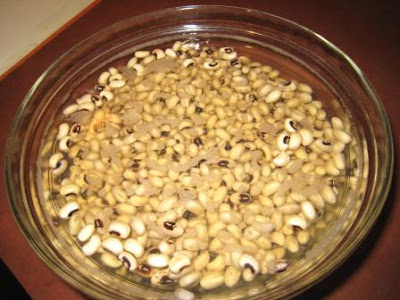 This recipe is from “Still Life With Menu” by Mollie Katzen. It’s easy, but the original makes a ton, so I halved it.
This recipe is from “Still Life With Menu” by Mollie Katzen. It’s easy, but the original makes a ton, so I halved it.
Black-Eyed Peas and Greens
- 1.5 c black-eyed peas, soaked for 8 hours or so.
- 3 c water
- 3 medium-sized cloves garlic, minced
- 3/4 t salt
- 3-4 c. (packed) chopped mixed greens
- 1 medium-sized leek, cleaned well and chopped.
- Place the black-eyed peas and water in a soup pot. Bring to a boil, lower the heat to a simmer and mostly cover. Cook gently until tender, checking the water level every now and then. If it appears to be getting dry, add water, 1/2 cup at a time. About 15 minutes into the cooking, add the garlic. The peas will take 30-35 minutes to cook
- When the black-eyed peas are just about tender, stir in the salt, greens and leeks. Cover, and continue to simmer just a few more minutes. The greens and leeks will cook very quickly.
- Season to taste with freshly ground black pepper and serve hot.
Chopping the collards.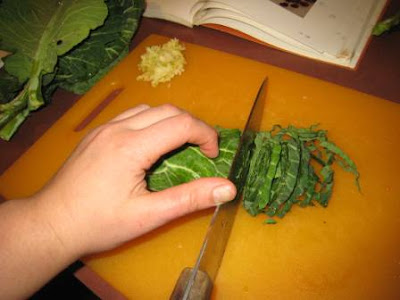 Prepping the leeks.
Prepping the leeks.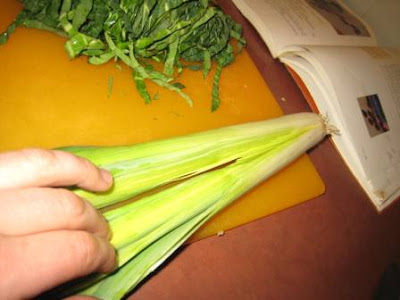 Chopping the leeks.
Chopping the leeks.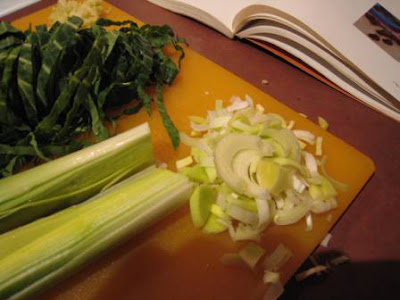 Sirring it all together.
Sirring it all together.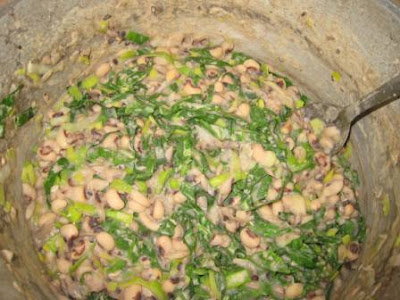 Mmmmm. Good luck and good food.
Mmmmm. Good luck and good food.
Christmas Squash Wreathes
Tara told me a recipe for squash and goat cheese and basil. This was the result and looked great on the Christmas dinner table. It tasted good too. Now you can make your own!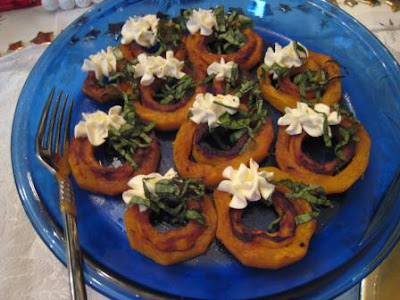 Behold, delicata squash. I happened to have a bigger one and a smaller one and they combined nicely to make thicker wreathes.
Behold, delicata squash. I happened to have a bigger one and a smaller one and they combined nicely to make thicker wreathes.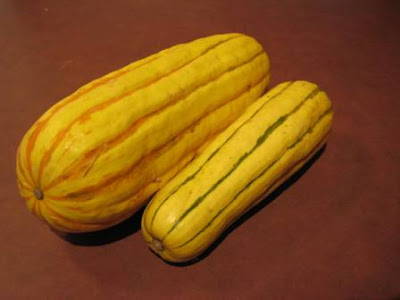 Peel using the technique explained here. This picture gets the gist of it, though.
Peel using the technique explained here. This picture gets the gist of it, though.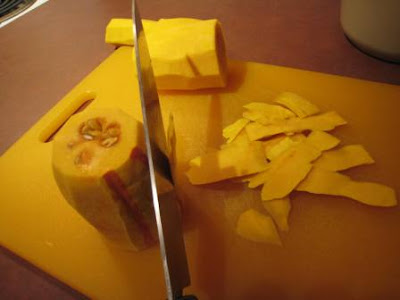 Slice into rounds and pull the gunk out of the center. I had an apple corer that worked great for the small size, but I used a small knife for the bigger rounds.
Slice into rounds and pull the gunk out of the center. I had an apple corer that worked great for the small size, but I used a small knife for the bigger rounds.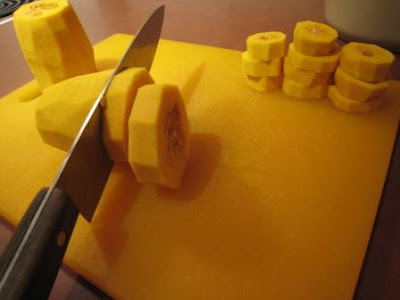 I was supposed to use goat cheese, but Fred Meyer was out of it. So I substituted cream cheese. I put mine in a pastry bag with a star tip to make those lovely stars, but you could just plop some in the center.
I was supposed to use goat cheese, but Fred Meyer was out of it. So I substituted cream cheese. I put mine in a pastry bag with a star tip to make those lovely stars, but you could just plop some in the center.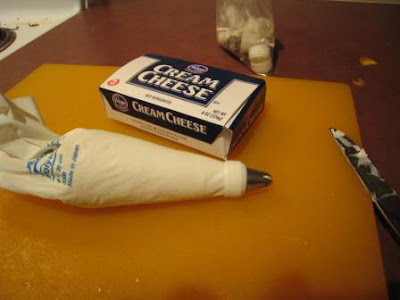 Toss the squash with some oil, salt and pepper in a bowl and then lay your Squash out on a baking sheet. Cook at 425 for 10 minutes, then flip over. Cook for 10 minutes more (or less, if they look like they are getting done.)
Toss the squash with some oil, salt and pepper in a bowl and then lay your Squash out on a baking sheet. Cook at 425 for 10 minutes, then flip over. Cook for 10 minutes more (or less, if they look like they are getting done.)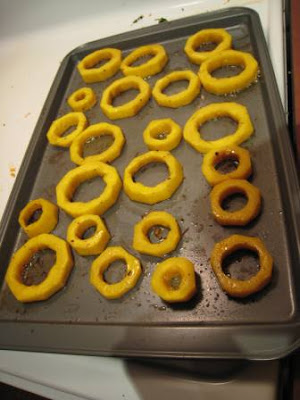 I let mine cool to room temperature, then stacked the smaller rings inside of the bigger ones. Then I took basil and chiffinad-ed it which I have no picture of, but this video nicely explains it. Use your star tip to make a few stars per wreath, sprinkle your basil over the top and enjoy.
I let mine cool to room temperature, then stacked the smaller rings inside of the bigger ones. Then I took basil and chiffinad-ed it which I have no picture of, but this video nicely explains it. Use your star tip to make a few stars per wreath, sprinkle your basil over the top and enjoy.
Note, if your squash is too hot, the cheese will melt and ruin your lovely star effect.
Next time I will get a butternut squash with a very long neck, peel it, cut the neck into slices and then quarters, then cook as above and top with goat cheese and basil. I think it will also be yummy.
Peeling a winter squash.
Occasionally, Matthew Card will contribute to the Oregonian’s FoodDay section. I really like his features, because they are about eating economically and produce some yummy food. This week, though, in his feature about winter squash, he said he likes the taste of winter squash but “most varieties have crenelated exteriors that make it nearly impossible to peel them while raw, so they must first be roasted, and then the soft flesh scraped free of the skin and pureed.”
To which I say, “Piffle.” Winter squash can be peeled. Is it an athletic event? Yep. Are you sometimes in danger of slicing your hand open? Sure, if you aren’t careful, but the danger can fulfill your sense of adventure. Is it a bit time consuming? A bit, but roasted cubes of squash sans peel are one of my favorite things, and I’m not going to let a little time get in the way of that. Plus, peeling winter squash is something that leaves me with a feeling of great accomplishment. Before there was a hard round object, now, bite-sized pieces of soon to be delicious food.
Here is your step-by-step illustrated process for peeling winter squash. *Note, the steps for butternut squash are a bit different, but I didn’t have one on hand to take a picture of. I’ll go through those verbally at the bottom. Special thanks to my old roommate Mary Kistinger, who saw me about to massacre my own self while peeling a butternut squash and walked me through her technique.
Start with a squash. This Long Island Cheese that I grew is ideal to peel because of it’s smooth surface. Acorn squash is the biggest pain, especially if it has deep ridges. This is a huge squash so the scale is off, but you will get the idea.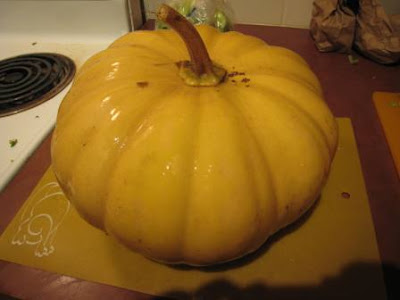 Sharpen your knife. Firmly and carefully plunge the knife into the top of the squash and cut as far down on one side as you can. Rotate the squash around and cut the opposite side the same way. This is one of the steps where you can slice your hand open if you aren’t careful as the skin is a bit thick and sometimes resistant to being cut. Sometimes rocking the knife a bit up and down helps, but keep your other hand out of the way. There aren’t too many times in modern life that you can plunge a knife into something, so enjoy this.
Sharpen your knife. Firmly and carefully plunge the knife into the top of the squash and cut as far down on one side as you can. Rotate the squash around and cut the opposite side the same way. This is one of the steps where you can slice your hand open if you aren’t careful as the skin is a bit thick and sometimes resistant to being cut. Sometimes rocking the knife a bit up and down helps, but keep your other hand out of the way. There aren’t too many times in modern life that you can plunge a knife into something, so enjoy this.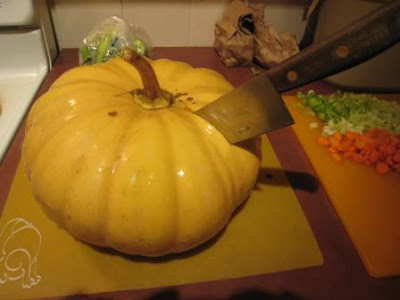 Flip the squash upside down and plunge the knife in again, pulling it as far down as you can, ideally joining up with the cut you made above. Rotate and do the other side.
Flip the squash upside down and plunge the knife in again, pulling it as far down as you can, ideally joining up with the cut you made above. Rotate and do the other side.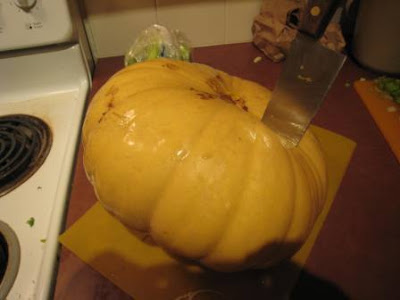 If your lines join up, you shouldn’t have much trouble separating the two halves. In this case, mine didn’t, as evidenced by the ridge on the right-hand side of the picture. The stem was also particularly difficult to crack open. I ended up flipping the whole thing upside down and using the knife as a sort of pry bar to split the two sides from one another. This is also another hand slicing opportunity, so be careful.
If your lines join up, you shouldn’t have much trouble separating the two halves. In this case, mine didn’t, as evidenced by the ridge on the right-hand side of the picture. The stem was also particularly difficult to crack open. I ended up flipping the whole thing upside down and using the knife as a sort of pry bar to split the two sides from one another. This is also another hand slicing opportunity, so be careful.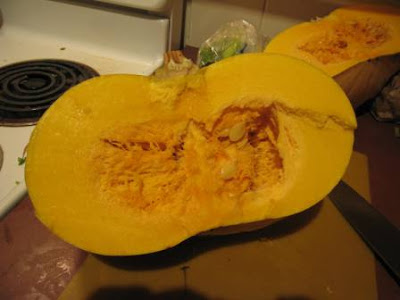 Scoop out the seeds and other gunky part with a big spoon. This always brings back happy memories of carving pumpkins. Interesting side note. Though we carved pumpkins every year I don’t think I had winter squash in an edible form until I went off to college. I wasn’t a pumpkin pie fan and I think that was the squash-i-est my family got.
Scoop out the seeds and other gunky part with a big spoon. This always brings back happy memories of carving pumpkins. Interesting side note. Though we carved pumpkins every year I don’t think I had winter squash in an edible form until I went off to college. I wasn’t a pumpkin pie fan and I think that was the squash-i-est my family got.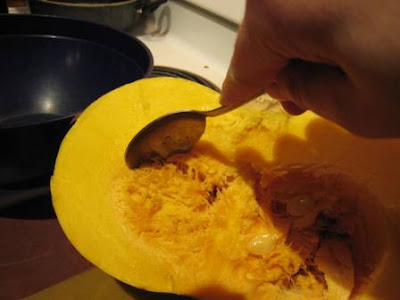 You are left with the flesh of the squash and, of course, the skin which you now have to remove. This was the first time carving into one of my own squash and I can say that it really does sort of look like cheese.
You are left with the flesh of the squash and, of course, the skin which you now have to remove. This was the first time carving into one of my own squash and I can say that it really does sort of look like cheese.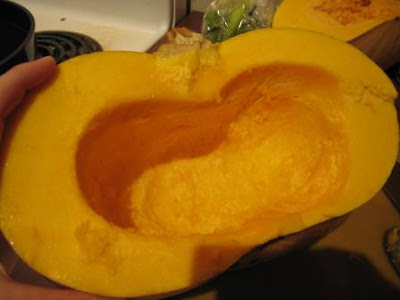 Set the squash on it’s bottom and carve a wedge off of the half. The size of this squash mandated big slices, but the smaller you cut your slices, the less waste there is.
Set the squash on it’s bottom and carve a wedge off of the half. The size of this squash mandated big slices, but the smaller you cut your slices, the less waste there is.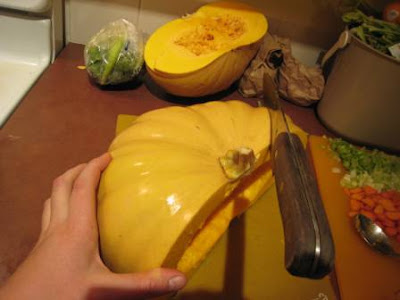 At this point, you can cut the whole half into wedges, or do the rest of these steps and then cut another wedge and repeat from here.
At this point, you can cut the whole half into wedges, or do the rest of these steps and then cut another wedge and repeat from here.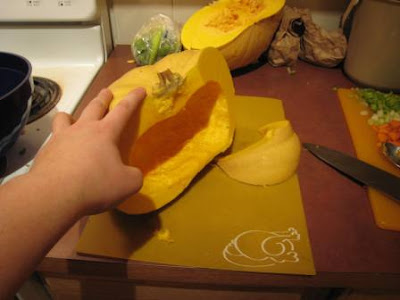 Set you wedge on its side and use your knife to slice off a bit of the skin. I took this photo from the side, but I do this by standing in front of the wedge and leaning over the slice. I always start in the middle and work outward, but I don’t see a reason why you couldn’t start from a side and work around. Keep slicing until you remove all skin. I flip over the squash and get the tiny bits on the other side the knife missed.
Set you wedge on its side and use your knife to slice off a bit of the skin. I took this photo from the side, but I do this by standing in front of the wedge and leaning over the slice. I always start in the middle and work outward, but I don’t see a reason why you couldn’t start from a side and work around. Keep slicing until you remove all skin. I flip over the squash and get the tiny bits on the other side the knife missed.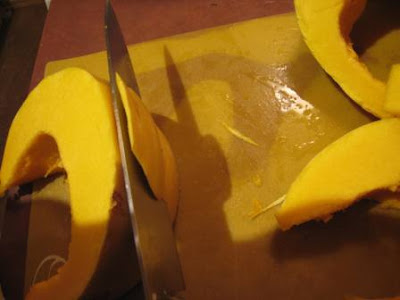 Once the skin is gone, slice the wedge into slices.
Once the skin is gone, slice the wedge into slices.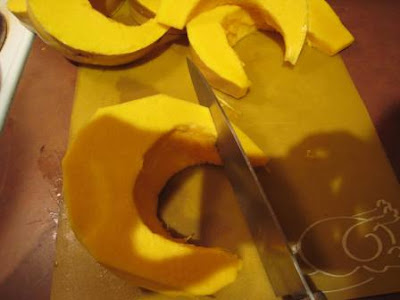 Then take your slices and chop them into the appropriate sized chunks for your recipe.
Then take your slices and chop them into the appropriate sized chunks for your recipe.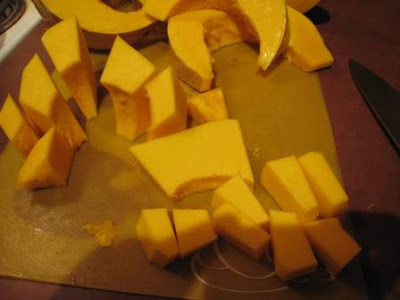 The first time you do this, it might take a long time and you will be very sweaty, but ideally emerge unsliced by a knife. After that, you will become much quicker.
The first time you do this, it might take a long time and you will be very sweaty, but ideally emerge unsliced by a knife. After that, you will become much quicker.
For butternut squash: Cut off the bulbous end. You now have the straight “top”side. Cut off the stem end. Stand this end upright (it will look like Devils Tower) and slice off the skin around the tower. You can then slice this tower of squash into what every you would like. Then cut the bulbous part in half and continue as above.
Easy roasted winter squash recipe gleaned from the FoodDay’s feature on roasting winter vegetables:
Preheat oven to 425 degrees.
Throw 2.5 lbs of squash [this is flexible, don’t stress if you have a bit more or less] cut into two-inch pieces in a bowl. Drizzle in 2 T olive oil, salt and pepper and toss. Put on baking sheet or in 9X13 pan. Sprinkle 2 teaspoons fresh chopped thyme over the top. Roast for 40 minutes, stirring a bit halfway through.
Cooking: Greens and Tofu Goodness
I used to eat this every day for breakfast when I had a schedule that allowed for cooking breakfast in the morning. It’s a great way to get some protein and vegetables early in the day. I like it without rice, but you could have some if that is your pleasure. I developed this while living at 85 Electric Avenue with a bunch of roommates. I’m not sure who thought of this combo first, but this is how it has evolved for me. Follow along as we make Greens and Tofu Goodness.
Your tools. Right now, I only have a microplane grater which is somewhat great, but tends to clog a bit and also include pieces of my knuckles in whatever I’m grating. I’m hopefully getting a box grater for Christmas. The compost bucket is optional.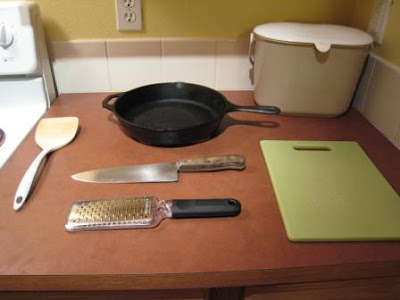 The supplies you will need. Back row: olive oil, soy sauce (or gluten free, more expensive, tamari in my case) nutritional yeast. Do not skip the nutritional yeast. It is what makes the dish. I find it in our bulk section of the grocery store. I like the large flake as the small flake makes me cough. Front row 1/2 onion, whole or piece of carrot, greens, firm or extra firm tofu (not silken). For the greens: my favorite is kale, but any kind of greens work well here. Today for instance, I had chard and collards.
The supplies you will need. Back row: olive oil, soy sauce (or gluten free, more expensive, tamari in my case) nutritional yeast. Do not skip the nutritional yeast. It is what makes the dish. I find it in our bulk section of the grocery store. I like the large flake as the small flake makes me cough. Front row 1/2 onion, whole or piece of carrot, greens, firm or extra firm tofu (not silken). For the greens: my favorite is kale, but any kind of greens work well here. Today for instance, I had chard and collards.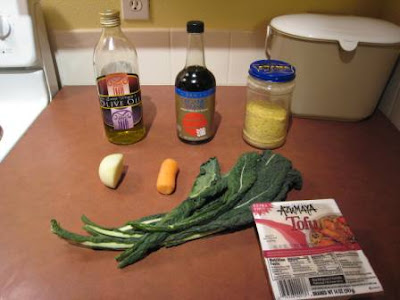 This is a prep-as-you-cook sort of recipe after the first few times you make it. You can start one step, and then chop for the next. It’s also not an exact science. So you aren’t going to read Tablespoon, or 1/2 cup here. It’s based on how much you want to eat.
This is a prep-as-you-cook sort of recipe after the first few times you make it. You can start one step, and then chop for the next. It’s also not an exact science. So you aren’t going to read Tablespoon, or 1/2 cup here. It’s based on how much you want to eat.
First heat your pan and put in some olive oil. Try Medium heat or just above. I read that for best non-sticking on cast iron skillets, heat the pan until the sides feel warm to you, then add the oil, then let the oil coat the bottom and only after it has heated do you add your ingredients. Note–my pan doesn’t usually look this bad. There was a bit of soaking that did not do good.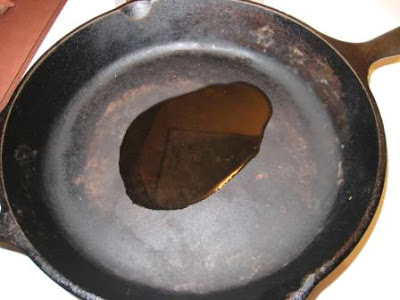 Chop your onion. I like slices, but you might like it chopped into bits.
Chop your onion. I like slices, but you might like it chopped into bits.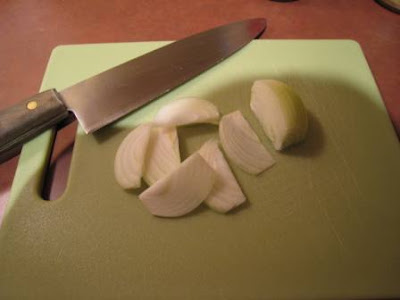 Chop your greens. Here, I am attempting to demonstrate the easy way of getting greens off of their stem I learned from America’s Test Kitchen. I ran out of hands though, so you will just have to imagine. Hold the green upside down by its stem. Run a sharp knife along the stem. The greens will fall off and you will be left with the stem. So easy.
Chop your greens. Here, I am attempting to demonstrate the easy way of getting greens off of their stem I learned from America’s Test Kitchen. I ran out of hands though, so you will just have to imagine. Hold the green upside down by its stem. Run a sharp knife along the stem. The greens will fall off and you will be left with the stem. So easy.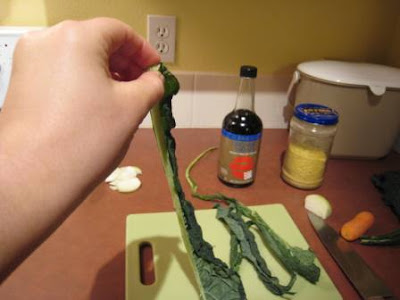 I usually pile my greens up and roll them into a cigar shaped tube. I then cut off slices of greens. dinosaur kale doesn’t lend itself to that, so I just piled it up and chopped.
I usually pile my greens up and roll them into a cigar shaped tube. I then cut off slices of greens. dinosaur kale doesn’t lend itself to that, so I just piled it up and chopped.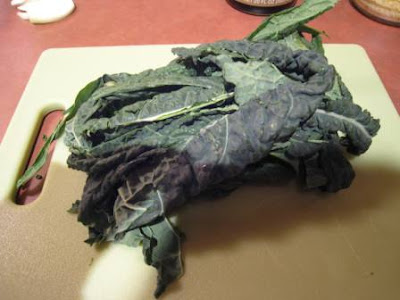
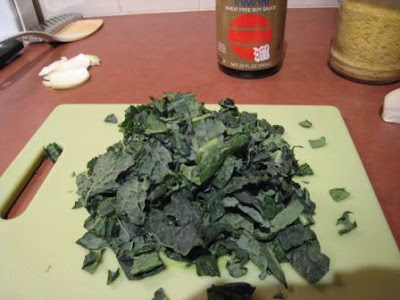 Grate your carrot. Avoid including knuckles.
Grate your carrot. Avoid including knuckles.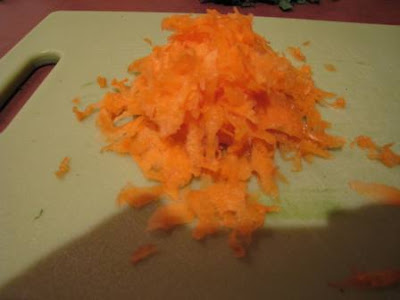 Crumble your tofu.
Crumble your tofu.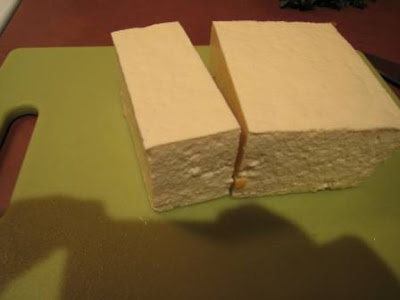
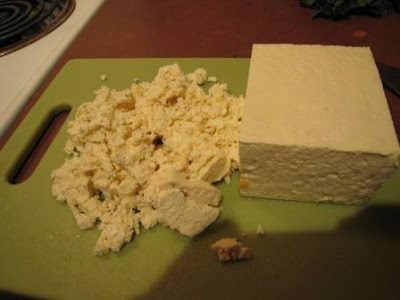 Cook your onions. I like them a little bit dark and limp.
Cook your onions. I like them a little bit dark and limp.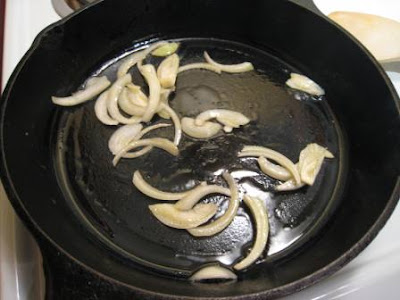 Add your greens and carrot. Stir them around until the greens are bright green and a little smaller.
Add your greens and carrot. Stir them around until the greens are bright green and a little smaller.
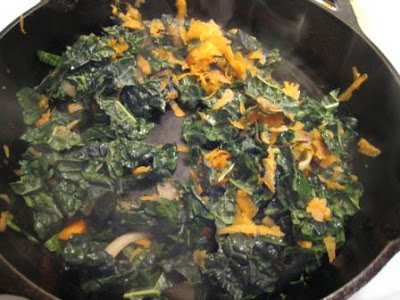 Add your tofu. I usually just crumble it in on top. Then it is time for crunch time. Stir the tofu around until it is warm, but not so long it sticks to the pan. Add the soy sauce and stir it around to distribute.
Add your tofu. I usually just crumble it in on top. Then it is time for crunch time. Stir the tofu around until it is warm, but not so long it sticks to the pan. Add the soy sauce and stir it around to distribute.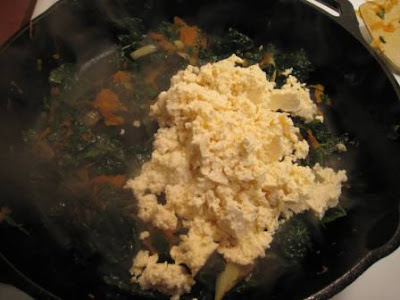 Throw the whole shebang onto your plate and sprinkle with nutritional yeast. Do NOT skip the nutritional yeast. It is yummy.
Throw the whole shebang onto your plate and sprinkle with nutritional yeast. Do NOT skip the nutritional yeast. It is yummy.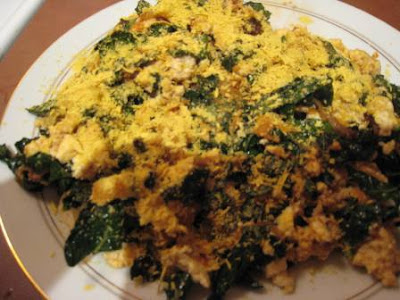 Eat and enjoy. After, cut up your remaining tofu and store it in water in a container. It will keep for awhile this way.
Eat and enjoy. After, cut up your remaining tofu and store it in water in a container. It will keep for awhile this way.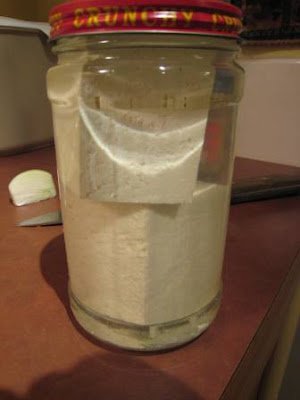 The recipe in short form without the pictures:
The recipe in short form without the pictures:
olive oil
1/2 onion
whole or piece of carrot
greens
firm or extra firm tofu
soy sauce
nutritional yeast
- heat your pan and put in some olive oil
- Chop your onion
- Chop your greens
- Grate your carrot
- Crumble your tofu.
- Cook your onions.
- Add your greens and carrot.
- Add your tofu.
- Stir the tofu around until it is warm, but not so long it sticks to the pan.
- Add the soy sauce and stir it around to distribute.
- Throw the whole shebang onto your plate and sprinkle with nutritional yeast.
- Eat and enjoy


